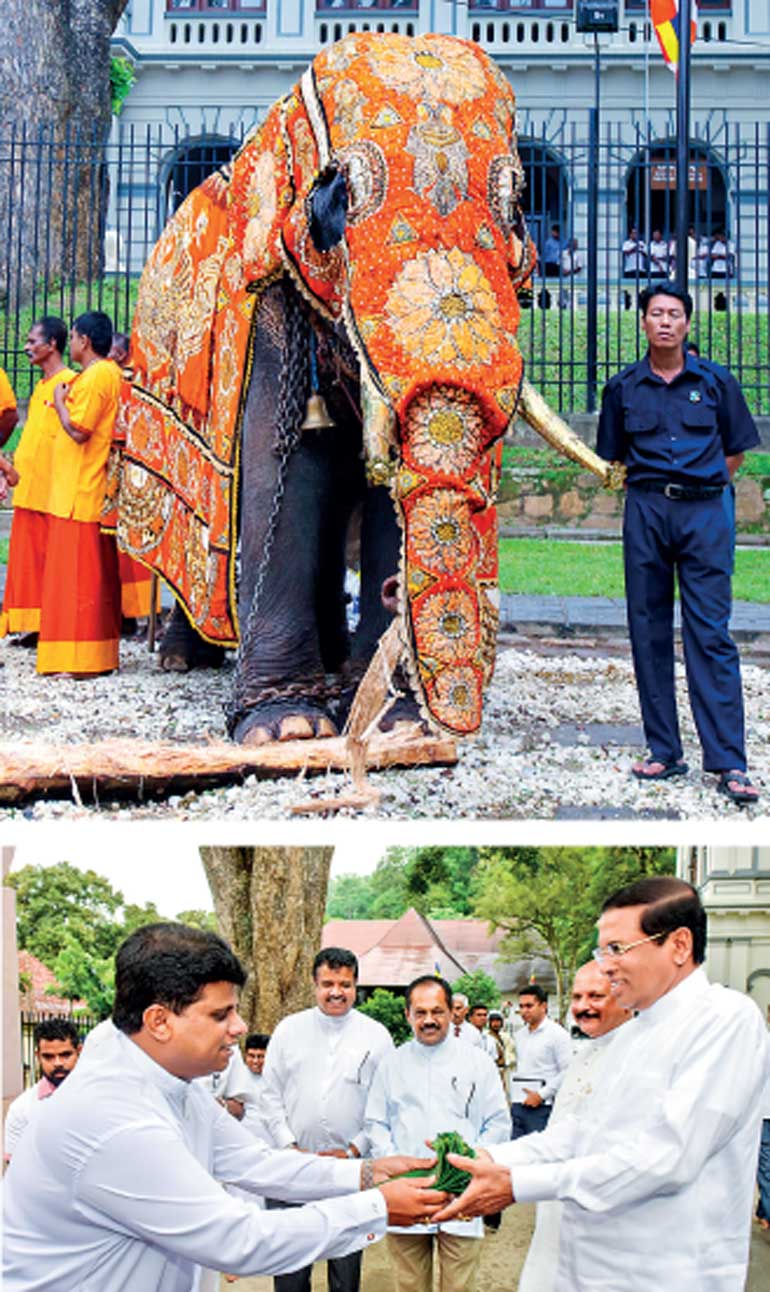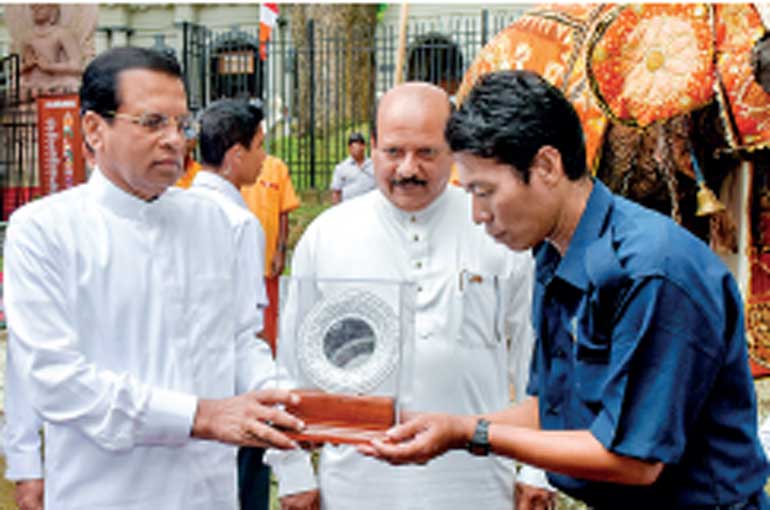Saturday Dec 06, 2025
Saturday Dec 06, 2025
Saturday, 16 September 2017 00:09 - - {{hitsCtrl.values.hits}}



 It was heartening to read that the group of tuskers at the Sri Dalada Maligawa has now been strengthened by one more. Following protocol, President Maithripala Sirisena formally handed over the tusker gifted by the Myanmar Government to the Diyawadana Nilame, Pradeep Nilanga Dela, the lay custodian recently. The tusker has been named Pulathisi Raja.
It was heartening to read that the group of tuskers at the Sri Dalada Maligawa has now been strengthened by one more. Following protocol, President Maithripala Sirisena formally handed over the tusker gifted by the Myanmar Government to the Diyawadana Nilame, Pradeep Nilanga Dela, the lay custodian recently. The tusker has been named Pulathisi Raja.
Just before the Esala Perahera in August there was some concern whether a tusker would be available to carry the relic casket. Though it was expected that Nedungamuwe Aththa would be available, he was being picked to perform duty at the Kataragama Perahera which coincided with the Kandy Perahera. Indi-Raja gifted by India carried the casket this year at the final Randoli Perahera. Perhaps one or two others would have been used on other days since with age some of them find it difficult to march several days one after the other.
Indi Raja is the second most senior tusker in the Maligawa group. He was gifted by the then Indian Prime Minister Rajiv Gandhi in 1986. The most senior member is Janaraja presented by President J.R. Jayewardene in 1985. He was born at the Dehiwala zoo.
With last week’s gifted tusker, there are now three from Myanmar in the Maligawa group. The other two – Myan-Raja and Buruma-Raja (they marched flanking Indi Raja) – have been in the group since 2007. Both were picked by the Diyawadana Nilame who went to Myanmar to select suitable tuskers when the need for more tuskers were felt. Both were then gifted by the Myanmar Prime Minister.
The rest in the group are Vijaya Raja (1986) gifted by the King of Thailand, Sinha Raja (1994) gifted by the Sinha Regiment of the SL Army, Maitri (1999) picked from the ‘Aturu Sevana’ – elephant orphanage at Uda Walawe and gifted by President Chandrika Kumaratunga, and Raju and Sindu – gifted by President Mahinda Rajapaksa in 2009.
At a time when it has virtually been accepted that there is a shortage of tamed elephants, the reported utterance by a Deputy Minister recently that elephants should be exported has naturally created a concern among animal lovers. It is rather strange to hear such a thing when we are lamenting that the elephant population in the country is declining.
 For a responsible member of the Government to make a contradictory statement not substantiated by facts and figures is rather disturbing. (So is his reported statement that shooting of wild boar should be permitted.)
For a responsible member of the Government to make a contradictory statement not substantiated by facts and figures is rather disturbing. (So is his reported statement that shooting of wild boar should be permitted.)
‘Elephant talk’ never seems to end. On one side, the human-elephant conflict has been talked about for the past few years with no solution still in sight. It’s again due to the clearance of the habitat they were used to for cultivation purposes. ‘Where do we go?’ is the simple question the elephants are asking.
In addition, there are other issues related to elephants. Illegal ownership by private parties who had not obtained licenses is an issue which created an uproar not so long ago. Some owners have even been taken to courts. There was also talk about a racket where young elephants were caught and sold.
The dearth of elephants was a hot topic of conversation just before the Perahera season a couple of months back. The Esala season sees a host of annual processions which, over the years have been held without a break.
Kandy, Kataragama, Bellanwila and Kotte are among the most popular ones which are keenly awaited by devotees during the season. There are more – Duruthu Perahera in Kelaniya, Navam Perahera at Gangarama and the Saman Devala Perahera in Ratnapura. For some unknown reason, the number of elephants at each of these Peraheras makes them more prestigious.
Coupled with the shortage is the problem of ageing elephants who find it difficult to repeatedly take part in procession for a number of days at a stretch. This problem mainly affects the ones carrying the relic casket who have been trained to observe certain rituals and march with decorum.
We rarely heard about elephant problems in some years back. I only remember talking about ‘Elephant Walk’ – a Hollywood film made in Sri Lanka in the mid-1950s. The country got a lot of publicity both during the filming and after the release of the film.
In the cast were one of the most popular actresses of the era, Elizabeth Taylor, who played the lead female role with Dana Andrews and Peter Finch doing the key male roles. Set in the tea country, the final act in the film showed a herd of elephants, numbering possibly around 30, angered that their path has been blocked by a tea plantation destroying the plantation and the bungalow. Coming to think of it, the human-elephant had been there from the days of the British Raj but was hardly talked about.